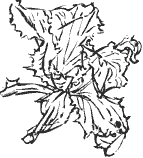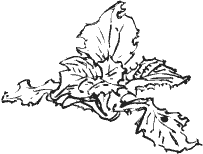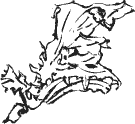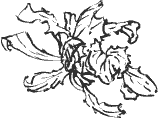Yummy!
|
A Love for LettucesSunday, 27th April 2003, West Yorkshire |
![]()
![]()
![]()
![]() Rocks | History |
Workshop |
Links | Home
Page
Rocks | History |
Workshop |
Links | Home
Page
![]()
 I'm
keen to work my way through John Ruskin's (1819-1900)
Elements of Drawing. I've already made a small start and this
morning, as we're chatting over a cup of coffee, I have a go at exercises
I and III. Ruskin suggests as a first step to perceiving tone and being
able to accurately represent it you should try, using a fine pen, to create
an even tone within a small ruled box and, in exercise III, to try and
draw a graduated band of tone, from dark to light.
I'm
keen to work my way through John Ruskin's (1819-1900)
Elements of Drawing. I've already made a small start and this
morning, as we're chatting over a cup of coffee, I have a go at exercises
I and III. Ruskin suggests as a first step to perceiving tone and being
able to accurately represent it you should try, using a fine pen, to create
an even tone within a small ruled box and, in exercise III, to try and
draw a graduated band of tone, from dark to light.

He suggests that you should create these gradations in tone with the same delicacy and care that you would take if you were drawing a butterfly's wing. I used a Pilot pigment ink drawing pen with a fine 01mm tip.

It is possible to find facsimile editions of Ruskins 1857 The Elements of Drawing but, for practical purposes, the illustrated edition with notes by Bernard Dunstan is more useful. It has been thoughtfully edited and some useful additional notes have been included. It is published by The Herbert Press, London, ISBN 0 7136 52144, paperback.
Lettuces in Line
 I
started exercise II the other day and found it very difficult. Ruskin
asks you to draw an exact copy of an outline drawing, such as a simple
illustration in a 'cheap work on botany'. You're expected to draw it the
same size - but without tracing!
I
started exercise II the other day and found it very difficult. Ruskin
asks you to draw an exact copy of an outline drawing, such as a simple
illustration in a 'cheap work on botany'. You're expected to draw it the
same size - but without tracing!
 I
go down to the greenhouse and, to my horror, find a monster slug crouched
under the leaf of one of the lettuces. I throw it, the slug, not the lettuce,
into the field. I decide to draw one of the lettuces for yesterday's diary
page (which was also concerned with slugs and lettuces, perhaps I'm getting
obsessed). Once I get going with my drawing and forget my worries I find
the lettuces attractive subjects to draw in brush pen.
I
go down to the greenhouse and, to my horror, find a monster slug crouched
under the leaf of one of the lettuces. I throw it, the slug, not the lettuce,
into the field. I decide to draw one of the lettuces for yesterday's diary
page (which was also concerned with slugs and lettuces, perhaps I'm getting
obsessed). Once I get going with my drawing and forget my worries I find
the lettuces attractive subjects to draw in brush pen.
 There's
an heraldic quality in their flounced jagged edges. I like their linear
quality so much that I decide it's not necessary to add a green wash to
my sketches.
There's
an heraldic quality in their flounced jagged edges. I like their linear
quality so much that I decide it's not necessary to add a green wash to
my sketches.
 I
can see why artists work in series when they find a subject or mode of
work they like. One's not enough is it? Or perhaps you don't share my
fascination with lettuce plants.
I
can see why artists work in series when they find a subject or mode of
work they like. One's not enough is it? Or perhaps you don't share my
fascination with lettuce plants.
But my brush pen lines with their varying thickness wouldn't meet with Ruskins approval, at least not for his exercise II:
'In most outline drawings of the present day, parts of the curves are thickened to give an effect of shade: all such outlines are bad, but they will serve well enough for your exercises, provided you do not imitate this character . . .'
Vigour and Vulnerability
There's something about their vigour and vulnerability that is both energetic and touching. The friends of mine that I love the most have some of the traits of these lettuce plants: a combination of a confident joy in life which gives you an energising buzz when you're with them, coupled with a vulnerability that melts your heart. I'm sure my friends will be pleased to be compared with lettuces.
![]() When
you think of the slugs that are lying in wait for them (this is the lettuces
now, not my friends) and the effects that a break in the water supply
would have on their succulent leaves you wonder how they're going to survive.
I'll try my best and I'll continue to cover them with a cloche each night.
When
you think of the slugs that are lying in wait for them (this is the lettuces
now, not my friends) and the effects that a break in the water supply
would have on their succulent leaves you wonder how they're going to survive.
I'll try my best and I'll continue to cover them with a cloche each night.
Plant and Planet
 It's
not so daft to identify with lettuces like this: when you sit to draw
a lettuce (or anything else for that matter) that vulnerable plant should,
for that moment, become the most important thing on the planet. What you're
going to eat for lunch (hopefully not the lettuce) or whether your finished
picture will be saleable (not very likely if you're going working through
your lettuce obsession as an artist) isn't relevant. Just get in that
mood of relaxed concentration and focus on the lettuce!
It's
not so daft to identify with lettuces like this: when you sit to draw
a lettuce (or anything else for that matter) that vulnerable plant should,
for that moment, become the most important thing on the planet. What you're
going to eat for lunch (hopefully not the lettuce) or whether your finished
picture will be saleable (not very likely if you're going working through
your lettuce obsession as an artist) isn't relevant. Just get in that
mood of relaxed concentration and focus on the lettuce!
![]()
![]() Next page | Previous
page | This day in 2000
| This month | Nature
Diary | Home
Page
Next page | Previous
page | This day in 2000
| This month | Nature
Diary | Home
Page
![]()